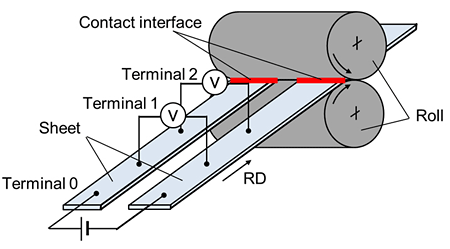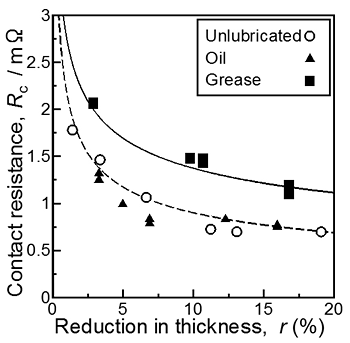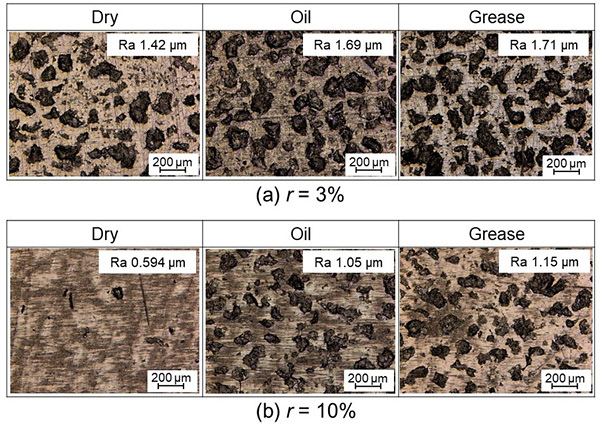In industrial rolling processes, liquid lubricant is mostly used to decrease the friction between the sheet and the rolls. Understanding of the contact state of the interface is one of the most important issues in rolling tribology. If the amount of the lubricant on the interface is insufficient, rolling load is heavy due to high friction. While, if the amount is more than enough, the rolled products show rough surface due to oil-pit formation. Therefore, the amount of lubricant should be controlled in an optimum range. However, it is not easy to observe the interface directly. The film thickness of lubricant is often estimated with fluid dynamics. It is believed that real contact area in microscopic scale is much smaller than macroscopic contact area, because both the sheet and the rolls have surface asperities. If the fraction of real contact is known, the rolling tribology should progress further. However, direct observation of the contact interface is not easy because of high speed and heavy load.
For the measurement of the contact resistance during rolling, it is desirable to measure the difference in electrical potential between the sheet and a roll. However, the precise measurement is not easy because the rolls rotate at high speed so that a slip ring, which has finite resistance, is needed to compose a closed circuit. In order to solve the problem, two sheets are rolled in parallel at once in this study. A closed electric circuit is composed with the two sheets, the roll and a DC power supply as shown in Fig. 1. The difference in electric potentials, i.e., voltage, between the two sheets is measured to estimate the contact resistance.
For the accurate measurement of resistivities, the four-terminal method is used. Pairs of terminals are numbered Terminal 0, 1 and 2 from the tail end of the sheet. A pair of Terminal 0 are directly connected to a DC power supply. Difference in electric potential between pair of Terminal 1 and that of Terminal 2 are measured. Dividing the potential difference by the current, the overall resistance R is calculated. The contact resistance Rc can be obtained by subtracting the sheet resistance RSheet, roll resistance RRoll from the overall resistance R.
Cold rolled and pickled pure titanium sheets with surface roughness Ra=2.76 µm were used. The dimensions were 1.00 mm thick, 300 mm long and 30.0 mm wide. 3 pairs of terminals, Terminal 1, 2 and 3 were putted on the two sheets at the positions every 30.0 mm distant from the tail ends. The spacing between the two sheets was 29.6 mm. Electric current of 2.00 A was applied to the closed circuit composed with the two sheets, the roll and DC power supply. Rolling experiment was conducted on a 2-high mill with bearing steel rolls 130 mm in diameter. The surface roughness on the rolls was Ra=0.116 µm. Thickness of the sheets was reduced r=1![]() 20% by rolls at 2.00 m/min of peripheral speed. Three lubrication conditions, (a) unlubricated (dry), (b) with rolling oil (kinematic viscosity: 15.3 mm2/s), and (c) with grease (kinematic viscosity: 117 mm2/s), were examined.
20% by rolls at 2.00 m/min of peripheral speed. Three lubrication conditions, (a) unlubricated (dry), (b) with rolling oil (kinematic viscosity: 15.3 mm2/s), and (c) with grease (kinematic viscosity: 117 mm2/s), were examined.
Obtained contact resistance is shown against the reduction in thickness in Fig. 2. The contact resistance decreases with reduction in thickness. This is mainly because of the increase in contact length with increasing reduction. The contact resistance under oil lubrication is close to that under dry conditions, while that under grease lubrication is higher than those of the other two lubrication conditions.
Photographs of the rolled sheet surfaces are compared in Fig. 3. Initial surface was very rough Ra=2.76 µm due to the pickling treatment. The surface was flattened remarkably even with small reduction (r=3%). The fraction of bright flat area increases with reduction in thickness. After 10% rolling, dull area disappears mostly under dry conditions, while the sheets rolled with oil or grease still have rough area with surface roughness around Ra=1.1 µm. We can find small amount of grease squeezed out from rough area on flat part of surface in case of grease lubrication.
A new technique to measure the contact resistance between the sheet and a roll is proposed. The technique, which is based on four-terminal method, enables in situ measurement of contact resistance during rolling. The technique has been applied to cold rolling of titanium sheets. The contact resistance decreases with increasing reduction in thickness. The contact resistance under grease lubrication is higher than those under dry and oil lubrication. It implies that the contact ratio under grease lubrication is lower.


